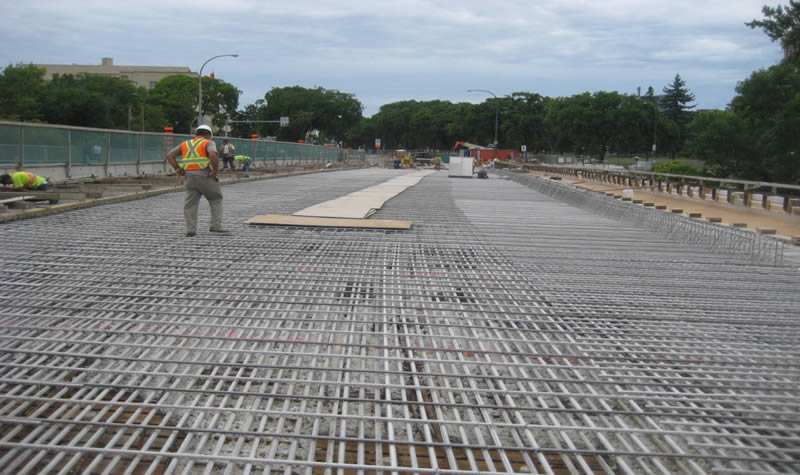Product Application
Product Applications
Stainless steel rebar may be considered where an effective corrosion-resistant rebar is required in the following general applications :
- Highway Infrastructure
- Marine Infrastructure
- Low magnetic permeability
- Industrial
- Pre-assembled cages for CIP end uses
- Precast end uses
Welded pre-assembled rebar cages are supplied for cast-in-place bridge elements such as piers and columns, welded assemblies for precast applications such as I-beam girders, box girders and pre-assembled elements for municipal public works applications.
Highway Infrastructure
Stainless steel reinforcing is used for structures in highway infrastructure applications where corrosion will have the effect of causing premature deterioration of the highway network resulting in possibly severe economic impacts to the surrounding community. With stainless the builder essentially “Gets in, Gets out and Stays Out”. Stainless steel reinforcing ensures that the useful life without repair is dramatically increased.
- Bridge structure elements
- Decks and deck panels
- Barrier walls and curbs
- Sidewalks and medians
- Deck joint blockouts
- Abutments roof slabs, approach slabs and wing walls
- Bridge piers and pier caps
- Bars projecting from precast deck panels
- Anchoring systems
- Tunnels
- All other chloride splash zones
- Highway elements
- Load transfer dowels
- Concrete pavements


Marine Infrastructure
Stainless steel reinforcing is used for structures in a marine environment where corrosion could be an acute design challenge. By using stainless steel reinforcing, the useful life of a marine structures is dramatically increased.
- Marine structures
- Coastal bridges
- Piers
- Wharves
- Tunnels

Low Magnetic Permeability End Uses
Austenitic stainless steels – though primarily XM-28 given its price point — are used in reinforced concrete applications where the low magnetic permeability characteristic of this type of steel is required so as not to interfere with the functioning of sensitive electronic devices housed by the facility in question.
- Non-magnetic applications include
- Hospital and medical clinic MRI’s
- Light rail transit
- Naval submarine deperming facilities
- Other facilities containing sensitive electronic equipment


Industrial End Uses
End uses include stainless steel for mining operations with severe corrosion environments such as potash or for chemical plant facilities.
Pre-assembled Cages for Clip End Uses
Cast-in-place or CIP construction involves forming and pouring concrete at the job site. SSR works with designers and contractors to help make projects more affordable and increase the level of quality and standardization of the reinforcement by supplying pre-assembled reinforcement.
SSR supplies stainless steel reinforcing rebar and mat assemblies for a wide range of transportation projects, industrial structures, water and wastewater treatment facilities, and high rise residential construction.
List of poured-in-place structures using stainless steel pre-assembled rebar cages or mesh.
- Rebar cages for beams
- Reinforcing assemblies for girders
- Reinforcement cages for columns and caissons
- Pre-assemblies for floors and landings
- Pre-assemblies for concrete components of water and wastewater treatment facilities and pumping stations

Pre-cast Concrete End Uses
There is an increasing interest by pre-casters in out-sourcing pre-welded rebar and mesh reinforcing assemblies for many reasons, primarily cost and operational efficiencies such as:
- Business economies relating to
- a reduction in space requirements associated with an in-house rebar shop
- efficiencies in SSR’s rebar purchasing power and fabrication
- more timely access to rebar supply
- shedding the cost of carrying stainless steel inventory
- no risk of rebar contamination
- just-in time delivery, saves on semi-finished goods inventory costs
- investment in equipment and training is reduced
- Quality control requirements, welding procedures and the associated costs of external consultants, testing agencies, and specifying authorities are all down-loaded to SSR
- Potential in-plant accidents and injuries associated with rebar fabrication are reduced by out-sourcing

